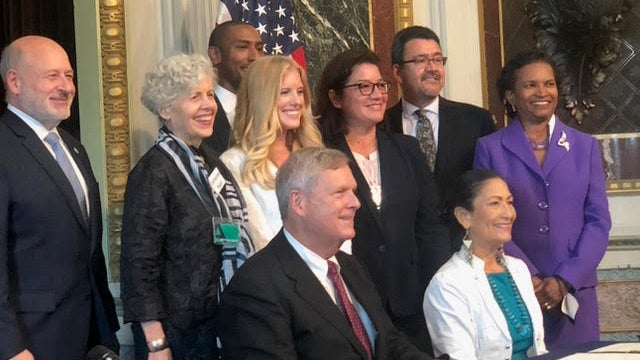The Biden Administration announced today, July 21, the reestablishment of the Federal Interagency Council on Outdoor Recreation (FICOR). The move will make it easier for more people from more diverse backgrounds to recreate on federally managed public land, and will help the outdoor recreation industry continue to grow. Here’s how.Ěý
“Federal agencies don’t have a built-in structure to prioritize recreation and then collaborate on the trends of record-breaking recreation interest and increased visitation, climate impacts on public lands and waters, decaying infrastructure, equitable access, new technologies, and more,” says Jess Turner, President of the (ORR), who lobbied for the council’s return. “So, we pushed for a mechanism to ensure agencies address these issues as whole rather than piecemeal, and FICOR does just that. In short, FICOR will make the outdoors more accessible, equitable, and positive to more Americans while bolstering the national and local outdoor recreation economies.”
FICOR was first created in 2011 by the Obama administration. It was responsible for the creation of , a website that allows you to book campgrounds, permits, passes, and tours on federal land, all on a single website. It also began tracking outdoor recreation as an economic sector, leading to the first analysis of that industry’s economic impact. And it established the , which allows every fourth grader—and their families—free access to national parks and other federally managed outdoor areas. Those are three important, successful initiatives that have fundamentally altered the way Americans get outside. FICOR was suspended during the presidency of Donald Trump.Ěý
The newly established FICOR will be made up of leaders from the Departments of the Interior, Agriculture, Commerce, and Defense. A White House statement says they’ll, “focus on improving access to nature, expanding outdoor recreation opportunities, and providing the public with improved and more affordable experiences on America’s public lands and waters.”

The statement calls out four areas of focus, which read:
-
Investing in resilient recreation infrastructure, such as electric vehicle charging stations, trails, campgrounds, visitor centers, docks, and boating access;
-
Bolstering education and career opportunities in conservation, outdoor recreation, habitat restoration, and resource management work, and Ěýproviding comprehensive visitor information for the hunting, fishing, hiking, biking, birding, climbing, and boating communities;
-
Cooperating with State, Tribal, territorial, and local governments, including those in communities near Federal lands and waters; and
-
Improving equitable access to Federal lands and waters and creating a welcoming visitor experience in collaboration with private, public, Tribal, and nonprofit organizations.
Turner’s ORR also identified key areas FICOR could address:
- Overcrowding on public land
- Improving public access to recreation data
- Reforming how user fees are directed to ensure effectiveness
- Coordinating rollout of funding from the Bipartisan Infrastructure Law and Great American Outdoors Act
- Developing sustainable and ongoing funding structures
- Improving equitable access to the outdoors
- Ensuring gateway communities roll in decision making
- Managing and mitigating impacts of climate change on public lands and waters
- Create new system to encourage use of alternative and active transportation on public lands
- Expand electric vehicle charging stations across public lands and waters
“Solidifying FICOR could not have come at a better time to support America’s public lands, waters, and $689 billion outdoor recreation economy,” says Turner. “It is critical that federal land and water management agencies work together to address important recreation issues around funding, overcrowding, and climate resiliency, as well as coordinate on the implementation of newly passed measures that will address the maintenance backlog, infrastructure priorities, and distribution of Land and Water Conservation Fund dollars.”


